Germinating wheat for food: methods and rules
Eating sprouted grains wheat usually causes a surge of strength, general rejuvenation of the body. How to properly germinate grains and consume them?
Content:
- The benefits of sprouted seeds
- Seed requirements
- Seed preparation and germination methods
- Storage of germinated seeds
- Seed intake and dosage
The benefits of sprouted seeds
Sprouted seeds of various crops are used to regulate the intestines, in case of dysbiosis caused by the use of antibiotics or other reasons. During the period of the emergence of a sprout, all useful substances pass into a form that is easily absorbed by the human body. Sprouted grains contain a lot of proteins, amino acids, vitamins, and useful chemical elements.
Germinated and used for food:
Most often, sprouted wheat grains are consumed along with legumes. They are pretty tough. And you can only swallow them crushed. But chewing on tough food strengthens your gums and teeth. You can grind the seeds along with the sprouts with a blender, adding fruits and cinnamon.
Do not use sprouted grains with dairy products. This causes diarrhea. When heat treated, all the benefits of the seedlings are lost.
Seed requirements
Sprouted wheat is used to improve the health of the body. Therefore, the seeds must be of high quality. You can buy grain from a specialty store. There they are required to have the conclusion of the sanitary and epidemiological services. So that there is no doubt about the quality of the seeds, you can ask the seller to show it. If the quality of the product was confirmed during the first purchase, then you can buy it in this place in the future.
In addition to quality guarantees, the document specifies the manufacturer and the main characteristics of the seeds.
Wheat is sometimes bought from producer farmers. But in this case, you need to know well the conditions for its cultivation. Determine how far from the transport routes and industrial enterprises was the site on which the crops were harvested, how many times and how the crops were cultivated.
In no case should you use pickled seeds. They can only be used for sowing. High-quality wheat seeds germinate in one day. But sometimes about half of the grains remain unhatched. This indicates the low quality of the grain.
Seed preparation and germination methods
Do not take metal utensils for germination. It is best to use glass jars or plastic food containers. It's a good idea to make cheesecloth to keep the seeds from drying out. You can instead cover the container with a lid, but loosely so that air can easily pass to the seeds and back.
It is better to soak the seeds in the morning. First, they are washed under a tap to wash off foreign impurities. You can pour water in a bowl, then remove all floating grains, because they will not germinate. Some sources recommend that each of the stages of germination be accompanied by disinfection with a pink solution of potassium permanganate. Prepare it in a separate jar using boiled water.
After each treatment, the grains are washed 3 times with water.
But you can limit yourself to rinsing with ordinary drinking water.It is much faster, easier, and extra potassium permanganate in the body is useless. After all, it is unlikely that it will be possible to completely wash it.
The seeds are poured for 3 minutes. Then they are drained, washed at least three times with filtered, spring or bottled water. It is convenient to do this through cheesecloth attached to the edge of the can with an elastic band.
Wheat seed germination methods:
- Germinating seeds in a tilted jar. Swollen seeds are poured into a jar, filling it by a third. Cover with gauze, fix it with an elastic band. Place the jar in the bowl so that its neck rests on the bottom of the bowl, and the walls on its edge. Tilt angle approx. 45 °. Most of the seeds should stay closer to the bottom of the jar. Water is poured into the bowl so that it does not pour into the jar, but flows onto the gauze, moistening it. The seeds are moistened, and the bottom of the upturned jar keeps moisture from evaporating. High-quality seeds begin to germinate within 8 hours. Wash them without removing the gauze. It is advisable to dive into a bowl of water in the evening so that they are ready for use by lunchtime.
- In a container. If the first method seems difficult, you can spread the swollen wet seeds along the bottom of the dish in a thin layer (up to 3 cm), cover them with gauze folded in several layers. The seeds should not float in the water, but they should not be overdried either. To adjust the amount of moisture, you can put cheesecloth folded several times on the bottom of the dish. Germinated at a temperature of about 20 ° C.
It is advisable to rinse the seeds through a strainer every 5-8 hours. This removes the mucus formed during the germination process, and the seeds themselves are moistened. If they are covered with gauze, this step can be omitted. But during germination, it is advisable to rinse the wheat seeds at least 2 times. They should have a pleasant aroma.
The grains are washed in the evening and in the morning. You can eat them around lunchtime. The volume of grain in the process of germination increases by 2 times. It is only necessary to distinguish the seeds that have hatched from those that have swollen, but did not germinate. They did not have a sprout.
Storage of germinated seeds
Wheat grains can be consumed when the white sprouts are clearly visible. With a length of 3 mm, the seeds have maximum efficiency. Then the amount of nutrients begins to decrease.
Do not use grains, the sprouts of which have darkened.
Sprouted seeds are stored in the refrigerator for 2 days. You can put them in a jar and cover them with a glass lid that does not fit snugly against the edge. Do not store in an open container, because this way the sprouts dry out. The temperature inside the refrigerator should not exceed 7 ° C.
In the morning, all the seeds are washed. Then the required part is selected for consumption, the rest are hidden back in the refrigerator. Repeat the procedure every morning. There is no need to worry about the sprouts continuing to grow during storage. At this time, the amount of vitamins and antioxidants in the sprouts increases, and enzymes are synthesized. Starting to accept grains with barely hatched sprouts, they finish when their length reaches 3 mm.
Seed intake and dosage
Process germinating seeds wheat requires a certain investment of time. Therefore, it is better to calculate it so that it is convenient.
- For the first couple of months, you should not take sprouted grains every day. They have a very strong energetic effect, so you need to introduce them into the diet gradually.
- You can take germinated seeds for 5 days, and take a break for 2 days. This is the best mode to start receiving. After the body gets used to it, you can consume the sprouted seeds daily, increasing the dose.
- Initially, an adult can take 1 tablespoon, which is equal to 20 g. The maximum dose for them is 70 g. The optimal dose is 50 g.
- Sprouted wheat seeds can also be given to children. From 5 to 8 years old, 1 teaspoon is enough, up to 14 years old - one dessert. Do not increase the dose for children. Some experts advise against giving grain to children under 14 years of age.
- To calculate the amount of dry grains, take into account that from 70 g (3.5 tablespoons) after germination, 100 g of germinated are obtained.
The seeds used for the prevention and improvement of the general condition are eaten, mixed with cottage cheese, various salads. If you need to get rid of dysbiosis, use it separately, half an hour before meals.
More information can be found in the video:
Major mistakes:
- Not everyone succeeds in germinating wheat the first time. Sometimes grains die from excess water. Therefore, you need to drain it, leaving the grains moist.
- If the grains are spread over the dishes in a too thick layer, they will not be able to breathe, overheat and will not germinate.
- When germinating for a long time, after the sprouts reach 3 mm, the quality of the product begins to deteriorate.
- Do not take germinated grains for patients with duodenal ulcers and people with gluten allergies.
At the beginning of use, side effects may appear:
- The head is spinning.
- Loose stools.
- General weakness.
Normally, these phenomena can last no more than 2 days. If they persist, you should refrain from taking sprouted grains.



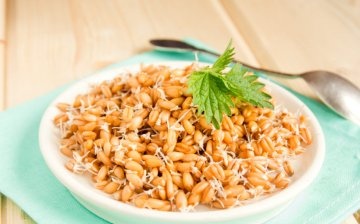

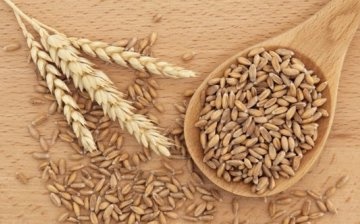
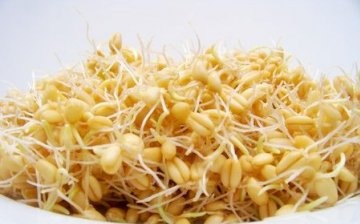
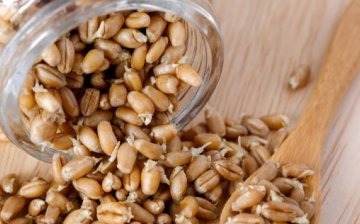
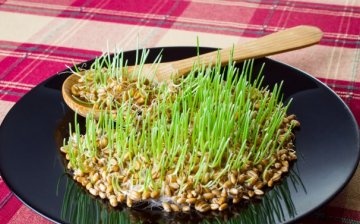






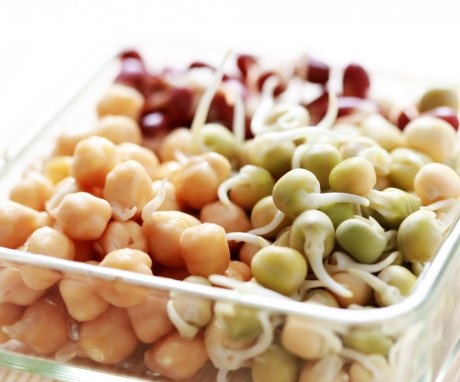

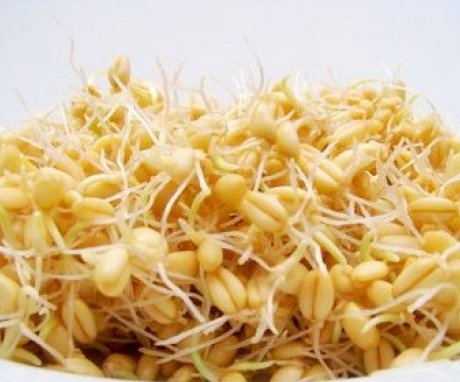
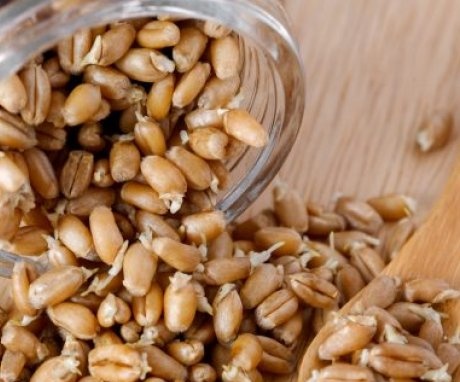
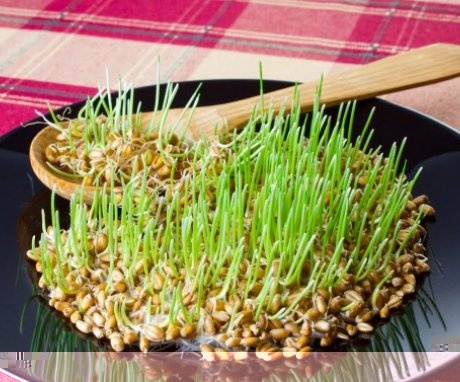
I, too, did not succeed in germinating the grains the first time, but when I filled my hand, it began to turn out well. I use thawed water. I got rid of dysbiosis. Now I am preparing this dish for all household members.
I have long wanted to try sprouted wheat, but did not know how to do it right. Now I will use the advice from the article, in principle, nothing complicated, the main thing is that there is an incentive!
I sprout wheat in wet gauze. The main thing is to carefully lay out the grains in one layer so that they do not interfere with each other. My first seedlings appear in a couple of days. Then we eat grains. I usually add them to salads. There is no need to wait for very long seedlings, since there will no longer be any special value in the grains.